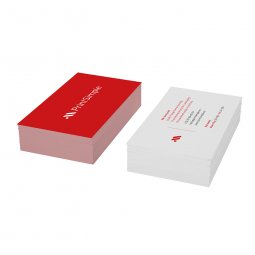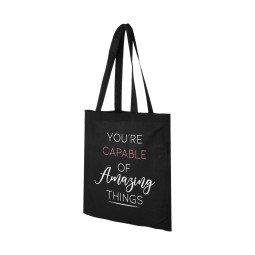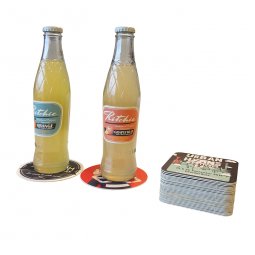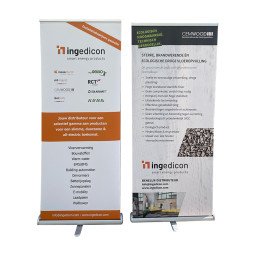Which personalization technique should I choose for textile items?
Imagine you would like to order textile items with your logo, name or other text. A lot of different personalization techniques exist for printing: screen printing, flex, transfer, ... Not all techniques are available for all products and/or for every print position or print run. Availability depends on:
- the material from which the product is made, e.g. cotton or polyester;
- the curvature of the surface, for example caps and drinking bottles have a rounded/curving surface;
- the shape and size of the product, i.e. the product can be mounted or fixed in certain decoration machines;
- the demand for that specific technique and/or product, i.e. more techniques are available for best-selling products.
Each decoration technique has its own maximum number of colors, maximum decoration size and the possibility to show more or less details of a design. Also, each personalization technique may have different set-up costs and decoration costs per piece. And finally, the delivery time may be different for each method. For example, embroidery usually takes longer than screen printing or DTG printing of textiles.
Different decoration techniques to personalize textile items
Not sure what each technique entails and which one to choose? Below we explain the different personalization techniques.
Flex
 This technique is used if each item must be personalized differently, e.g. having different names or numbers or for very small runs with one-color and simple (e.g. a brand name or simple logo such as PrintSimple's own) designs.
This technique is used if each item must be personalized differently, e.g. having different names or numbers or for very small runs with one-color and simple (e.g. a brand name or simple logo such as PrintSimple's own) designs.
Our recommendation:
- when printing individual names and numbers on textiles
- with simple, mono-colored designs
- from 5 pieces
Screen print
 Screen printing is simple, cheap and the most common technique for identical prints on all items. Screen printing is the ideal technique to personalize t-shirts, sweatshirts and polo shirts with prints in up to 8 colors.
Screen printing is simple, cheap and the most common technique for identical prints on all items. Screen printing is the ideal technique to personalize t-shirts, sweatshirts and polo shirts with prints in up to 8 colors.
Note: textiles consist mainly of polyester or other artificial fibers. There is a risk of bleeding, chemical reaction and discoloration between textile and print. If you really want to go for a screen print on synthetic material, please contact us first to check the possibilities.
Screen printing is not recommended for all textiles. For example, when you want to personalize hats, we do not recommend using a screen printing. On the one hand because the material has an uneven surface and the print can clump, on the other hand because the print can break open when the textile is being stretched and worn. In this case, we would recommend embroidery, which you can find further down.
Types of screen printing: screen printing with respectively plastisol (very durable, good for PMS color matching), water-based ("soft hand" effect, good for pastel colors, more ecological), or silicone (good for stretchy textiles) inks.
Our recommendation:
- for larger quantities of t-shirts, polo shirts, hoodies, sweaters, etc.
- interesting with limited number of (spot) colors
- from 5 pieces (up to very large runs)
Transfer
 Transfers are widely used for printing on textiles that mainly consist of polyester or other synthetic fibers, for printing on textiles that cannot be stretched on a screen printing mill and for printing in full color. In the latter case we speak of a color transfer or a digital transfer. This print has a more detailed result and clearer colors than screen printing. Available from 15 pieces.
Transfers are widely used for printing on textiles that mainly consist of polyester or other synthetic fibers, for printing on textiles that cannot be stretched on a screen printing mill and for printing in full color. In the latter case we speak of a color transfer or a digital transfer. This print has a more detailed result and clearer colors than screen printing. Available from 15 pieces.
Transfer types: monochrome transfers, multicolor/full color/digital transfers.
Our recommendation:
- on hats & caps, baby textiles (bibs & rompers), tote bags & umbrellas
- with polyester, nylon and softshell jackets
- interesting alternative to screen printing with many colors
- from 15 pieces
DTG or direct-to-garment
DTG or direct-to-garment (sometimes called DDG or Direct Digital Printing) is digital printing that allows printing directly on the textile. Printing is done in a cost-effective way in full-color and is available in small quantities. Suitable for small print runs and images or logos with many colors, especially if the base material is a white textile color.
Our recommendation:
- for small print runs & full-color logos
- best result on white textiles
- from 5 pieces
Embroidery
 Embroidery gives an exclusive look and is possible up to 12 colors. An embroidery is a personalization technique that does not fade during washing and therefore remains beautiful for a very long time. This technique is not recommended for (thin) T-shirts, since the fabric contracts which gives not so great results. However, on fleece materials we do recommend choosing an embroidery. To keep the price interesting, you are best off ordering in multiples of 6.
Embroidery gives an exclusive look and is possible up to 12 colors. An embroidery is a personalization technique that does not fade during washing and therefore remains beautiful for a very long time. This technique is not recommended for (thin) T-shirts, since the fabric contracts which gives not so great results. However, on fleece materials we do recommend choosing an embroidery. To keep the price interesting, you are best off ordering in multiples of 6.
Types of embroidery: e.g. 2D embroidery, 3D embroidery (also called "puff embroidery" due to the 3-dimensional effect).
Our recommendation:
- for polo shirts, sweaters, shirts, jackets, towels & co, blankets, tote bags, caps & hats
- for fleece material and terry cloths
- from 6 pieces
Debossing
With debossing, an image or logo is stamped in the material, which leaves an imprint of this logo in the material. No color is added, so the logo will be visible in the color of the material.
Our recommendation:
- for softshell jackets, fleece jackets and fleece blankets
- from 5 pieces
Infusion or sublimation
 With infusion or sublimation, the ink is pressed not on, but rather into the fabric. The result is a photo-realistic full-color design that you do not feel on the textile afterwards. It does not fade or break when the material is stretched. This technique is used, among other things, to fully print textiles with your colors and logo. Ideal for complex full-color images and small runs on white textile items.
With infusion or sublimation, the ink is pressed not on, but rather into the fabric. The result is a photo-realistic full-color design that you do not feel on the textile afterwards. It does not fade or break when the material is stretched. This technique is used, among other things, to fully print textiles with your colors and logo. Ideal for complex full-color images and small runs on white textile items.
Our recommendation:
- for technical clothing and sports textiles
- with polyester or other synthetic materials
- best result on white textiles
- from 10 pieces
Laser engraving
 Laser engraving etches your design or logo into a surface with a laser beam. No color is added, so your logo has the color of the textile it is etched in but can differ in shade or take on the color of the material that is just below the top layer.
Laser engraving etches your design or logo into a surface with a laser beam. No color is added, so your logo has the color of the textile it is etched in but can differ in shade or take on the color of the material that is just below the top layer.
Our recommendation:
- with softshell jackets, fleece jackets and fleece blankets
- from 5 pieces
So, what to choose?
First determine what is important to you: fast delivery, the lowest price, high quality, certain effect, size, position, ...? In addition, determine the number of colors to be printed: 1, 2, 3, ..., PMS colors or full color? Then you quickly arrive at a technique.
Tip: change your online product configuration and scroll to the overview at the bottom of the page to check the delivery time, maximum decoration size and price for that specific simulation, as these may differ.
Are you still not sure which technique you use best? Please contact us, together we will find the best solution.



